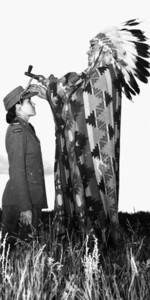Mary Greyeyes
| Surname | Greyeyes |
| Given Name | Mary |
| Country | Canada |
| Category | Military-Ground |
| Gender | Female |
Contributor: C. Peter Chen
ww2dbaseMary Greyeyes was born into the Native American Meskeg Lake Cree Nation in Saskatchewan, Canada in 1920. In Jun 1942, following the footsteps of her brother who had already enlisted in military service, she traveled to Saskatoon to enlist as well. As the sergeant told her of her acceptance, she became the first Native American woman to join the Canadian armed forces as a member of the Canadian Women's Army Corps. Although she was the subject of a famous photograph meant to increase recruitment into the military, she would find that she was discriminated against by fellow Canadians, barred from regular barracks and constrained to menial jobs such as laundering or cooking, due to her ethnicity.
ww2dbaseIn late Jun 1942, within the first month of her military career, several men from the Royal Canadian Mounted Police visited the Piapot reserve, looking to stage a propaganda photograph with Greyeyes. They ran into WW1 veteran and councilor Harry Ball, who agreed to partake in this effort in exchange of 20 dollars. Pieces of clothing and accessories that might contain Native American flare were borrowed from nearby homes to make Ball appear to be a chief or someone of importance. The resulting photograph, depicting a Native American chief bestowing blessing upon the patriotic and uniformed Greyeyes, quickly became a famous photograph in Canada after first being published in the Regina Leader-Post. Quickly, the photograph was published all across the British Empire. Somewhere along the way, it gained the official caption of "Unidentified Indian princess getting blessing from her chief and father to go fight in the war". It would be many decades before Melanie Fahlman Reid, Greyeyes' daughter-in-law, could successfully persuade Library and Archives Canada to include Greyeyes' name in the caption; LAC's current caption for the photograph would still contain the "chief" description, however.
ww2dbaseDespite the newly gained fame, Greyeyes was kept in menial positions. She was shipped out to southern England, United Kingdom to wash laundry and then to cook. As one of the few Native Americans in service in the region, she was often brought to events where diversity was needed, thus she was often seen in newspapers, and she was given the opportunity to meet the Queen Mother, King George VI, and Princess Elizabeth.
ww2dbaseAfter the war, Greyeyes returned to Canada in 1946. She passed away in 2011. She was also known by her post-marriage last name of Greyeyes-Reid.
ww2dbaseSources:
Melanie Fahlman Reid, "What Does This Photo Say?", "The Tyee", 7 Aug 2012
Wikipedia
Last Major Revision: Apr 2015
Photographs
 |
Você gostou deste artigo ou achou este artigo útil? Se sim, considere nos apoiar no Patreon. Qualquer valor já vai ajudar! Obrigado. Por favor, ajude-nos a divulgar o site: Fique atualizado com WW2DB: |
Visitor Submitted Comments
All visitor submitted comments are opinions of those making the submissions and do not reflect views of WW2DB.

- » Wreck of Teruzuki Found (27 jul 2025)
- » USS Orlean's Bow Found (22 jul 2025)
- » The Emperor of Japan Planned to Honor WW2-era Japanese POWs in Mongolia (4 jul 2025)
- » US State Lawmaker John Winter Caught Using Racial Slur "Jap" and Apologized (11 jun 2025)
- » US Government Plans to Purge WW2 Information (17 mar 2025)
- » Ver todas as notícias
- » 1,181 biografias
- » 337 eventos
- » 45,132 entradas na linha do tempo
- » 1,249 navios
- » 350 modelos de aeronaves
- » 207 modelos de veículos
- » 376 modelos de armas
- » 123 documentos históricos
- » 261 instalações
- » 470 resenhas de livros
- » 28,427 fotos
- » 365 mapas
George Patton, 31 May 1944
Por favor, considere nos apoiar no Patreon. Mesmo R$1 por mês já faz uma grande diferença. Obrigado!
Ou, por favor, nos apoie adquirindo alguns produtos do WW2DB na TeeSpring. Obrigado!
15 Apr 2015 01:57:07 PM
Mary Greyeyes was, unfortunately, also a woman. Women were, in general,discriminated against by fellow Canadians,barred from some places, paid less than men doing the same skilled job and often constrained to menial jobs because of their gender. I admire and respect Mary Greyeyes for sticking it out despite this and ALSO for the extra difficulties she may have pencountered because she was a native woman in the military.